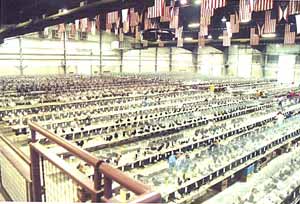 |

|
Currently there are no events or updates to display. |

Conditioning Calls and East Indies for the Showroom When I think about preparing birds for the showroom, I actually consider three separate criteria. First, I consider overall health. No bird in poor health will do well in a competitive situation under normal circumstances. Under the heading of health, I would include freedom from any ailment such as sinusitis, eye infection, etc. Such problems are not life threatening but can affect not only appearance but also behavior. I also include in this category freedom from parasites including worms, mites and lice. All of the afore mentioned problems must be effectively addressed well before the bird goes to the show. If they cannot be addressed, the bird should be left at home not only because it will not win but also because the stress of showing may well make the problem worse.
Another aspect of health is weight. An underweight bantam duck will not possess the smooth form a judge looks for in an excellent show specimen. The second major criteria are plumage and skin condition. Badly soiled or damaged feathers will usually doom an otherwise superior bird to "also ran" status at most shows. There are simply too many fine birds around today for most judges to overlook such things. Like health, this area must be addressed weeks before the show arrives. Broken or excessively soiled feathers must be removed with enough time left before the show to allow the feather to re-grow. That may well mean six weeks for a primary feather. The next item to be addressed in this category is condition of the skin on the feet, legs, and bill. During the winter in particular, dead skin can accumulate in all three areas and should be removed. Once that is done, Vaseline or some other natural moisturizer should be applied to those areas. Also, do not forget to trim toenails if necessary. Waiting until the last minute to trim those may well backfire if one nicks a blood vessel in the nail and blood stains the plumage. Last but certainly not least is cleanliness. With bantam ducks, this should be the easiest aspect of conditioning to accomplish if the birds are kept in clean quarters for at least week or so before the show and if they are provided with clean bathing water that is changed on a daily basis. The birds will bathe and the bathing will prompt them to preen and oil their feathers. Mission accomplished. Before ending my discussion on this topic, let me leave you with a list of simple do 's and don'ts.
Do Select birds for show and begin the conditioning process weeks in advance. A recipe for failure is selecting birds by flashlight the night before the show. Attend to the details. Removing soiled or broken plumage, cleaning the areas around the eyes, etc. may make that little bit of difference it takes to win. Prepare a backup bird or two. Things happen. Be prepared. Spend some time coop training young birds. A Call or an East Indie put in a show coop and handled in the way a judge may handle it a number of times before that first show will usually behave more calmly and show it's best qualities better. Spray every bird for mites and lice before each show and when it comes home from each show. Do Not Overcrowd birds in conditioning pens or put "fighters" together in those pens. Neglect to have appropriate carrying coops clean and ready for the trip to the show. What a shame to go to the trouble of conditioning a fine group of birds for a show only to have that work spoiled by transporting them in crowded, dirty carriers. Do not leave your sense of perspective at home when you attend a show. The world will not end tomorrow if you lose. Take it from someone with over thirty years of show experience: the good and bad breaks even out in the long run. You will lose some placings you should have won and you will win some you should have lost. Have fun! Originally published: 03-10-2003 Last updated: 02-28-2008 |
Copyright © 1997 - 2025 Acorn Hollow Bantams. All Rights Reserved. | Terms of Use | Privacy Policy


